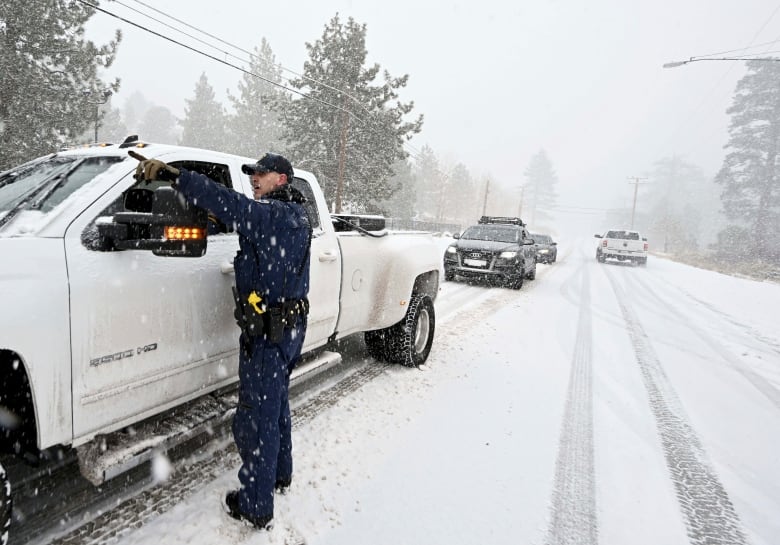
Much of the central United States from the Rocky Mountains to the Midwest was braced Tuesday for blizzard-like conditions, while states farther to the south saw tornadoes from a massive storm blowing across the country.
An area stretching from Montana into western Nebraska and Colorado was under blizzard warnings, and the National Weather Service said that as much as 61 centimetres of snow was possible in some areas of western South Dakota and northwestern Nebraska.
Meanwhile, ice and sleet were expected in the eastern Great Plains.
‘We are not kidding’ type of storm
The U.S. National Weather Service warned that up to about 2.5 centimetres of ice could form, and winds could gust up to between 45 and 72 km/h in parts of Iowa, Minnesota and South Dakota.
Power outages, tree damage, falling branches and hazardous travel conditions all threatened the region.
“This is a ‘we are not kidding’ kind of storm,” the South Dakota Department of Public Safety said Monday in a tweet urging people to stock up on essentials, then stay home once the storm hits.
This is a “we are not kidding” kind of storm. Rain and freezing rain followed by heavy snow and high winds. Keep updated on the latest forecasts. Reconsider any travel plans. Have enough supplies at home including prescription medications and all other necessities. <a href=”https://twitter.com/hashtag/keepSDsafe?src=hash&ref_src=twsrc%5Etfw”>#keepSDsafe</a> <a href=”https://t.co/nvgyyaxCiV”>pic.twitter.com/nvgyyaxCiV</a>
—@SDPublicSafety
Portions of Interstate 90 and Interstate 29 through South Dakota were expected to be closed by mid-morning Tuesday due to “freezing rain, substantial snow totals, low visibility, drifting snow and high winds,” the state’s Department of Transportation said. Secondary highways will likely become “impassable,” it said.
Farther south, tornadoes, strong winds, hail and flash flooding were expected Tuesday with eastern Texas, much of Louisiana and western Mississippi at greatest risk for severe storms.
Early Tuesday, tornado warnings were issued in parts of central Oklahoma and north Texas.
Damage was reported in the Oklahoma town of Wayne after the weather service warned of a “confirmed tornado” shortly after 5 a.m. on Tuesday.
Video footage from Oklahoma TV station KOCO showed substantial damage to a home in Wayne, which is about 72 kilometres south of Oklahoma City.
In Texas, at least two tornadoes were spotted along the front edge of the storm as it headed toward the Dallas-Fort Worth metropolitan area Tuesday morning, though the extent of any damage was not immediately known.
The severe weather threat continues into Wednesday for Louisiana, Mississippi, Alabama and the Florida Panhandle, according to the Storm Prediction Center in Norman, Okla.
Same system dumped snow in Sierra Nevada
“It will be a busy week while this system moves across the country,” said Marc Chenard, a meteorologist at the weather service’s headquarters in College Park, Md.
The weather is part of the same system that dumped heavy snow in the Sierra Nevada over the weekend before moving east.

In northern Utah, a tour bus crashed Monday morning as snow and frigid temperatures blanketed the region. The bus flipped onto its side in Tremonton after the driver lost control while switching lanes, the state’s Highway Patrol said in a statement. The Highway Patrol said 23 passengers were injured, including some seriously.
Thousands of students from Native American communities across Wyoming, Nebraska and the Dakotas were travelling to Rapid City, S.D., for this week’s Lakota Nation Invitational, a high school athletic event. Brian Brewer, one of the organizers, said he had urged schools and participants to travel early.
“We told them with this storm coming — if you leave tomorrow, there’s a good chance you might not make it,” he said Monday.
In Northern California, most mountain highways had reopened Monday. Remaining warnings in the Southern California mountains expired Monday night, the weather service said.
With winter still more than a week away, it was the latest fall storm to bring significant precipitation to California, which is dealing with the impacts of years of drought that have spurred calls for water conservation.
The UC Berkeley Central Sierra Snow Lab northwest of Lake Tahoe reported the storm dropped 138.5 centimetres of snow.
The Sierra snowpack, which on average is at its peak on April 1, is normally a significant source of water when it melts in the spring. Throughout the drought, experts have cautioned about optimism over early season storms as climate change makes what were once average conditions rare.
Last year, a powerful atmospheric river storm dumped huge amounts of rain on California in October and a wet stretch in December left parts of the Sierra Nevada buried in snow. Then the state experienced its driest January through April on record.